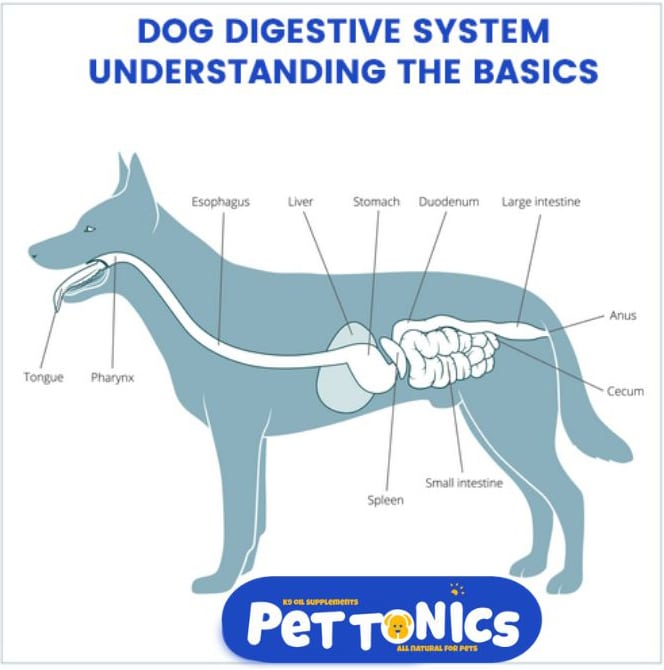Last Updated on 03/22/2023 by K9 Oil Supplements
The dog digestive tract is an important part of the dog body system for breaking down food, absorbing nutrients and excreting waste. The esophagus, stomach and small intestine are the first parts of this dog digestive tract system that you’ll see when looking at your dog from behind. The dog digestive tract parts are located in front of their rib cage. The large intestine (colon) is located just behind those muscles; and then where all those stools end up coming out of!

Dog Digestive Tract: The Esophagus
The esophagus is a long tube that connects the mouth to the stomach. It’s made up of muscle and lined with mucus, which helps it move food along quickly. The esophagus is attached to your diaphragm (the big pink muscle in your chest cavity), but it’s not located in one place–it also sits under your left lung. In fact, if you were able to see down through your rib cage, you’d see all your digestive organs floating around inside there!
Dog Digestive Tract: The Stomach
The stomach is a muscular organ that stores food, begins the process of digestion, and releases enzymes into it. The stomach is located between the esophagus and small intestine. It has three layers: mucosa (outermost layer), submucosa (middle layer), and muscularis (innermost layer).
The mucosa is made up of tough folds that protect underlying tissues from damage during swallowing or vomiting. It also has glands that secrete gastric juices to help break down food into smaller particles so they can be digested by enzymes secreted from cells in the duodenum, which leads directly into your small intestine
Dog Digestive Tract: The Small Intestine
The small intestine is about 7 meters long, and it’s where most of the digestion and absorption of nutrients takes place. It also happens to be the home turf for your dog’s bile salts, which help break down fats into smaller molecules so they can be absorbed by cells in the body. The bile makes its way through this organ via ducts (like those on a garden hose).
Dog Digestive Tract: The Large Intestine (Colon)
The large intestine (colon) is the last part of your dog’s digestive tract. It absorbs water and nutrients from waste matter, moves waste to the rectum for elimination, and acts as a filter for feces by absorbing toxic chemicals. The colon is about 5 feet long, but it’s not just one long tube like you might think; it has many twists and turns throughout its length.
The large intestine also can be called “the cecum” or “cecum.” Cecum means “small house” in Latin because this section looks like a small house when viewed on an x-ray image taken from above!
The dog digestive tract is a complex assembly of organs that play an important role in the overall well-being of your pet.
The dog digestive tract is a complex assembly of organs that plays an important role in the overall well-being of your pet. These include:
- The mouth, which includes teeth and tongue to chew food before it enters the stomach;
- The esophagus, which connects the mouth with the stomach;
- The stomach, where food is broken down into smaller particles;
- A small intestine (duodenum), which absorbs nutrients from digested food and passes them though its walls into blood vessels called veins. This area also contains many glands that produce gastric juice for digestion purposes only;
- Large intestine (colon), where waste products are stored until they can be removed by defecation or urination
Conclusion
As we’ve seen, the dog digestive tract is a complex assembly of organs that play an important role in the overall well-being of your pet. That said, it’s not uncommon for dogs to experience some kind of health problem that may require veterinary treatment or even surgery. But don’t worry! You can help prevent these issues by taking care of yourself and your dog’s digestion by feeding him a healthy diet and providing him with plenty of exercise every day.
The proof is in the poop! Learn more about what your dog’s poop can tell you.
Shop our K9 Oil Supplements here.


